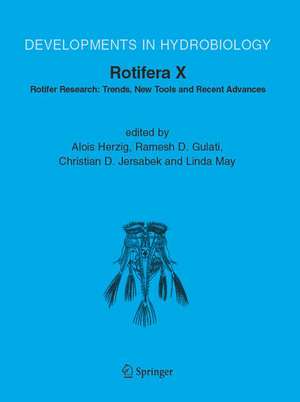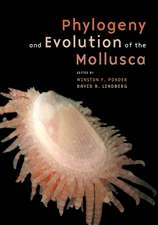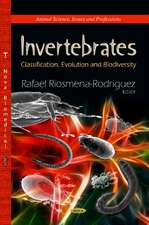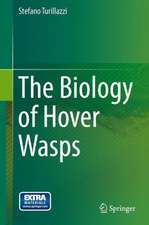Rotifera X: Rotifer Research: Trends, New Tools and Recent Advances: Developments in Hydrobiology, cartea 181
Editat de Alois Herzig, Ramesh D. Gulati, Christian D. Jersabek, Linda Mayen Limba Engleză Hardback – 13 oct 2005
| Toate formatele și edițiile | Preț | Express |
|---|---|---|
| Paperback (1) | 1082.51 lei 38-44 zile | |
| SPRINGER NETHERLANDS – 28 oct 2010 | 1082.51 lei 38-44 zile | |
| Hardback (1) | 1094.81 lei 38-44 zile | |
| SPRINGER NETHERLANDS – 13 oct 2005 | 1094.81 lei 38-44 zile |
Din seria Developments in Hydrobiology
- 18%
 Preț: 1229.10 lei
Preț: 1229.10 lei - 18%
 Preț: 959.98 lei
Preț: 959.98 lei - 18%
 Preț: 963.91 lei
Preț: 963.91 lei - 15%
 Preț: 648.24 lei
Preț: 648.24 lei - 15%
 Preț: 637.89 lei
Preț: 637.89 lei -
 Preț: 378.25 lei
Preț: 378.25 lei - 15%
 Preț: 644.95 lei
Preț: 644.95 lei - 18%
 Preț: 952.09 lei
Preț: 952.09 lei - 20%
 Preț: 558.87 lei
Preț: 558.87 lei - 18%
 Preț: 1833.65 lei
Preț: 1833.65 lei -
 Preț: 393.59 lei
Preț: 393.59 lei -
 Preț: 406.54 lei
Preț: 406.54 lei - 18%
 Preț: 1226.73 lei
Preț: 1226.73 lei - 18%
 Preț: 956.99 lei
Preț: 956.99 lei -
 Preț: 388.87 lei
Preț: 388.87 lei - 24%
 Preț: 1060.53 lei
Preț: 1060.53 lei - 18%
 Preț: 1229.28 lei
Preț: 1229.28 lei - 20%
 Preț: 569.31 lei
Preț: 569.31 lei -
 Preț: 368.79 lei
Preț: 368.79 lei - 24%
 Preț: 817.48 lei
Preț: 817.48 lei - 18%
 Preț: 958.25 lei
Preț: 958.25 lei - 18%
 Preț: 953.03 lei
Preț: 953.03 lei -
 Preț: 384.75 lei
Preț: 384.75 lei - 24%
 Preț: 1582.95 lei
Preț: 1582.95 lei - 24%
 Preț: 1051.70 lei
Preț: 1051.70 lei - 18%
 Preț: 943.57 lei
Preț: 943.57 lei - 18%
 Preț: 1235.76 lei
Preț: 1235.76 lei - 24%
 Preț: 800.05 lei
Preț: 800.05 lei - 24%
 Preț: 803.57 lei
Preț: 803.57 lei - 18%
 Preț: 948.29 lei
Preț: 948.29 lei
Preț: 1094.81 lei
Preț vechi: 1440.55 lei
-24% Nou
Puncte Express: 1642
Preț estimativ în valută:
209.52€ • 217.93$ • 172.97£
209.52€ • 217.93$ • 172.97£
Carte tipărită la comandă
Livrare economică 10-16 aprilie
Preluare comenzi: 021 569.72.76
Specificații
ISBN-13: 9781402034930
ISBN-10: 1402034938
Pagini: 616
Ilustrații: XIV, 602 p.
Dimensiuni: 193 x 260 x 43 mm
Greutate: 1.41 kg
Ediția:2005
Editura: SPRINGER NETHERLANDS
Colecția Springer
Seria Developments in Hydrobiology
Locul publicării:Dordrecht, Netherlands
ISBN-10: 1402034938
Pagini: 616
Ilustrații: XIV, 602 p.
Dimensiuni: 193 x 260 x 43 mm
Greutate: 1.41 kg
Ediția:2005
Editura: SPRINGER NETHERLANDS
Colecția Springer
Seria Developments in Hydrobiology
Locul publicării:Dordrecht, Netherlands
Public țintă
ResearchCuprins
Walter Koste - a K-strategist? A laudatio.- Walter Koste - a K-strategist? A laudatio.- Phylogeny and Evolution.- On the phylogenetic position of Rotifera — have we come any further?.- Speciation and selection without sex.- Bayesian and maximum likelihood analyses of rotifer-acanthocephalan relationships.- Evolutionary dynamics of ‘the’ bdelloid and monogonont rotifer life-history patterns.- Toward a better understanding of the phylogeny of the Asplanchnidae (Rotifera).- Genetics and Molecular Ecology.- Molecular ecology of rotifers: from population differentiation to speciation.- The potential of genomic approaches to rotifer ecology.- Using amplified fragment length polymorphisms (AFLP) to study genetic variability in several freshwater rotifer species.- Genetics and Molecular Ecology.- Molecular characterization of Mn-superoxide dismutase and gene expression studies in dietary restricted Brachionus plicatilis rotifers.- Behavioural reproductive isolation in a rotifer hybrid zone.- Taxonomy and Biogeography.- The ‘Frank J. Myers Rotifera collection’ at the Academy of Natural Sciences of Philadelphia.- Tale of a sleeping beauty: a new and easily cultured model organism for experimental studies on bdelloid rotifers.- Life on the edge: rotifers from springs and ephemeral waters in the Chihuahuan Desert, Big Bend National Park (Texas, USA).- Morphology and Ultrastructure.- Euryhaline Brachionus strains (Rotifera) from tropical habitats: morphology and allozyme patterns.- Morphological and morphometrical variations of selected rotifer species in response to predation: a seasonal study of selected brachionid species from Lake Xochimilco (Mexico).- Morphological stasis of two species belonging to the L-morphotype in the Brachionus plicatilis species complex.-Morphological variation of Keratella cochlearis (Gosse) in a backwater of the River Thames.- Trophi structure in bdelloid rotifers.- Study of the trophi of Testudinella Bory de St. Vincent and Pompholyx Gosse (Rotifera: Testudinellidae) by scanning electron microscopy.- Do rotifer jaws grow after hatching?.- External morphology and muscle arrangement of Brachionus urceolaris, Floscularia ringens, Hexarthra mira and Notommata glyphura (Rotifera, Monogononta).- The musculature of Testudinella patina (Rotifera: Flosculariacea), revealed with CLSM.- Rotifer nervous system visualized by FMRFamide and 5-HT immunocytochemistry and confocal laser scanning microscopy.- Identification of acetylcholinesterase receptors in Rotifera.- Mating, Resting Eggs, Diapause, Anhydrobiosis, Embryonic Development.- Brachionus calyciflorus is a species complex: Mating behavior and genetic differentiation among four geographically isolated strains.- Removal of surface glycoproteins and transfer among Brachionus species.- Maternal effect by stem females in Brachionus plicatilis: effect of starvation on mixis induction in offspring.- Restoration of tropical peat swamp rotifer communities after perturbation: an experimental study of recovery of rotifers from the resting egg bank.- Diapause in monogonont rotifers.- Anhydrobiosis of Adineta ricciae: costs and benefits.- A putative LEA protein, but no trehalose, is present in anhydrobiotic bdelloid rotifers.- The development of a bdelloid egg: a contribution after 100 years.- Population and Community Ecology.- Evolution of rotifer life histories.- Insulin-like growth factor signaling pathway involved in regulating longevity of rotifers.- Combined effects of algal (Chlorella vulgaris) food level and temperature on the demography of Brachionus havanaensis (Rotifera): a life table study.- Factors affecting egg-ratio in planktonic rotifers.- Factors affecting swimming speed in the rotifer Brachionus plicatilis.- An evidence for vertical migrations of small rotifers — a case of rotifer community in a dystrophic lake.- Structure distinctions of pelagic rotifer plankton in stratified lakes with different human impact.- Changes in rotifer species composition and abundance along a trophic gradient in Loch Lomond, Scotland, UK.- Diversity and abundance of the planktonic rotifers in different environments of the Upper Paraná River floodplain (Paraná State — Mato Grosso do Sul State, Brazil).- Relationships between rotifers, phytoplankton and bacterioplankton in the Corumbá reservoir, Goiás State, Brazil.- Short time-response of psammic communities of Rotifera to abiotic changes in their habitat.- The influence of biotic and abiotic factors on psammic rotifers in artificial and natural lakes.- Long-term Studies.- Seasonal rotifer dynamics in the long-term (1969–2002) record from Lake Kinneret (Israel).- Seasonality of rotifers and temperature in Lough Neagh, N. Ireland.- Abiotic vs. biotic factors: lessons drawn from rotifers in the Middle Loire, a meandering river monitored from 1995 to 2002, during low flow periods.- Trophic Interactions.- Freshwater copepods and rotifers: predators and their prey.- Trophic Interactions.- Life history characteristics of Asplanchnopus multiceps (Rotifera) fed rotifer and cladoceran prey.- Susceptibility of ephemeral pool Hexarthra to predation by the fairy shrimp Branchinecta mackini: can predation drive local extinction?.- Decline of clear-water rotifer populations in a reservoir: the role of resource limitation.- Combined effects of food concentration and temperature oncompetition among four species of Brachionus (Rotifera).- Application of stable isotope tracers to studies of zooplankton feeding, using the rotifer Brachionus calyciflorus as an example.- Aquaculture and Ecotoxicology.- Screening methods for improving rotifer culture quality.- Interaction among copper toxicity, temperature and salinity on the population dynamics of Brachionus rotundiformis (Rotifera).- Effect of some pesticides on reproduction of rotifer Brachionus plicatilis Müller.- Heat shock protein 60 (HSP60) response of Plationus patulus (Rotifera: Monogononta) to combined exposures of arsenic and heavy metals.









